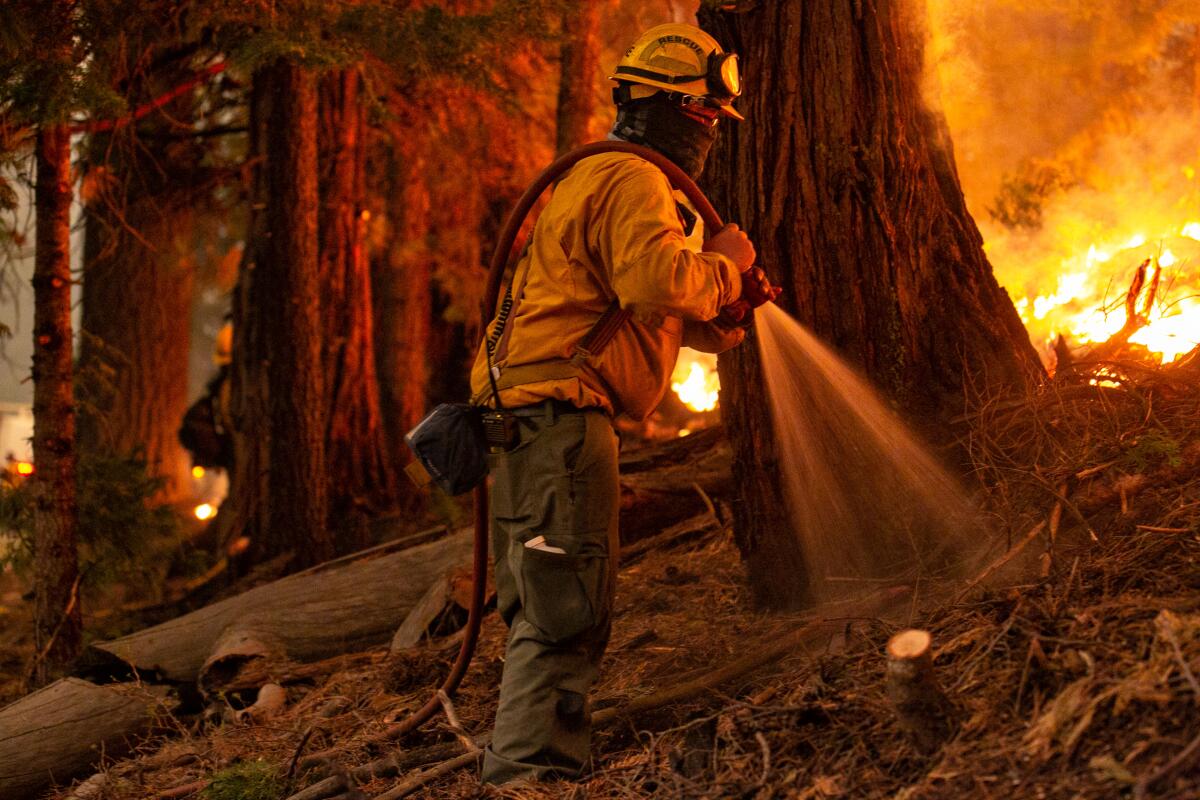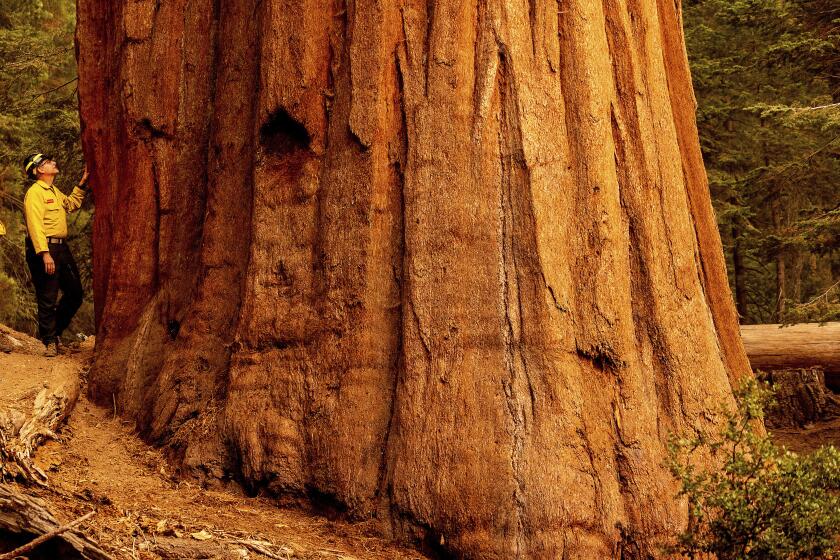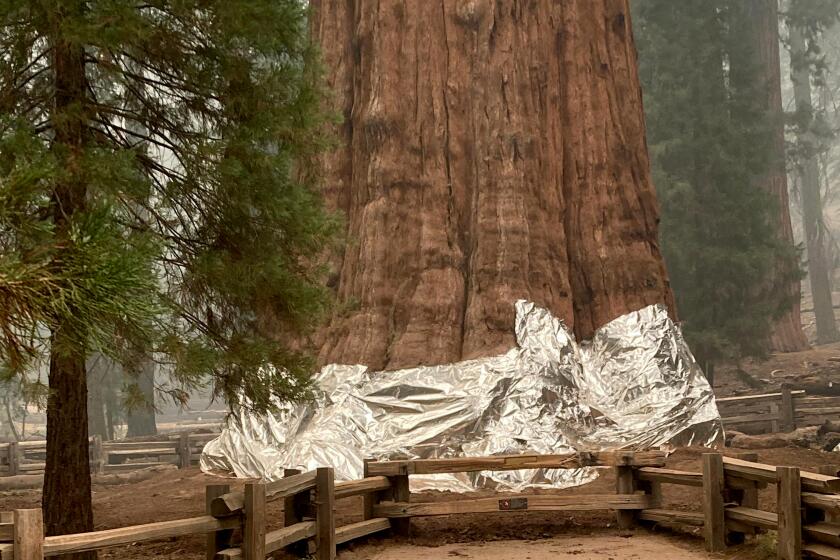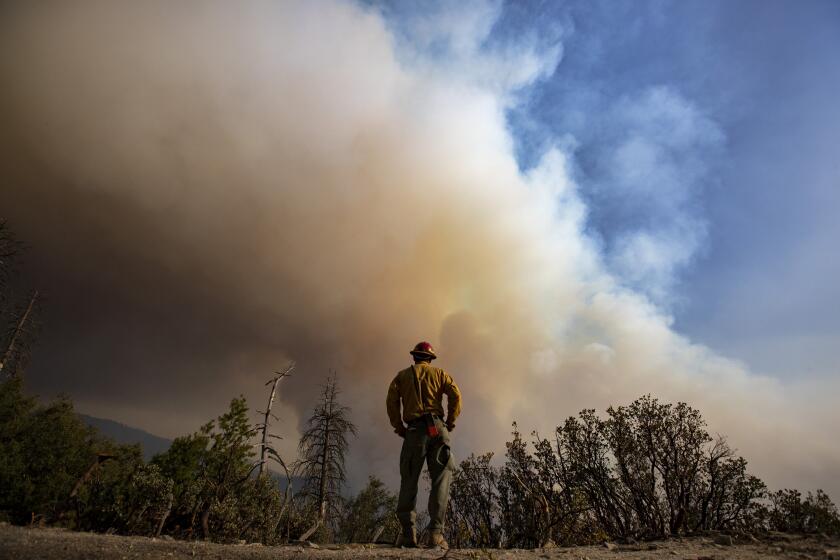Newsom signs ‘monumental’ law paving way for more prescribed burns

- Share via
Less than a month after prescribed burns were credited with saving California’s giant sequoia trees from the KNP Complex fire, Gov. Gavin Newsom on Wednesday signed legislation that will promote more of the practice in California.
Prescribed burns, also known as controlled burns, are the intentional use of fire to clear away dried vegetation that acts as fuel for wildfires.
Many ecologists have said that fire is necessary and healthy for California’s landscape and warned that decades of vegetation buildup throughout the state’s forests is enabling wildfires to grow faster, hotter and more quickly out of control.
The bill, SB 332, adds legal protections for those who conduct the burns for public benefit, including a number of groups who had been reluctant or unable to employ the practice because of dwindling insurance options and other complex barriers, according to experts who worked on the bill.
Many said the move is essential not only to help forests recover from a century of fire suppression, but also to better arm the state for wildfire response in the years to come.
Its passage is “so monumental,” said Lenya Quinn-Davidson, fire advisor for the University of California Cooperative Extension, who worked with Sen. Bill Dodd (D-Napa) in crafting the legislation. “These are things that we never thought we’d see in California.”
Crews have used controlled burns, protective foil and other protective measures to guard Sequoia National Park.
The bill limits the liability of private landowners and public agencies who use prescribed fires under specified conditions, including that the burn be for the purpose of wildfire hazard reduction, ecological maintenance and restoration, cultural burning or agriculture.
Those who are negligent in their use of fire will still be held accountable for fire-suppression costs or emergency services under the law, said Quinn-Davidson, who is also the director of Northern California Prescribed Fire Council.
It follows the passage of another recent bill, AB 642, which was signed by Newsom at the end of September. That new law charges the state fire marshal with developing a proposal to establish a prescribed fire training center, and will require the California Department of Forestry and Fire Protection to appoint a cultural burning liaison, among other items.
“California has always kind of fallen short on prescribed fire, and so the prescribed fire community for a long time has said we need to address liability, we need to address the insurance issues, we need to provide more training for people,” Quinn-Davidson said.
“And here we are — we’re at a moment where there’s finally recognition of these important pieces that are all needed to lift this work up.”
Officials are banking on a history of prescribed burns in Sequoia National Park to help keep destructive flames from reaching the towering trees of Giant Forest.
Prescribed fire is not new. For centuries, many of California’s Indigenous communities considered it essential for forest health and employed it to great success, along with similar burning practices applied for cultural goals and objectives.
But starting about 100 years ago, Indigenous burning practices were suppressed through aggressive policies that were intended to protect California’s residents, homes and infrastructure from fire. The U.S. Forest Service employed a “10 a.m. rule” through the 1970s, which prompted crews to put out every wildfire by 10 in the morning after a blaze ignited.
Many experts said those policies had a disastrous effect on the landscape, paving the way for a surplus of growth in the state’s forests. The combination of fire suppression and dried vegetation is partially what enabled the massive Dixie fire to burn nearly 1 million acres this year.
Michael Wara, a senior research scholar at the Woods Institute for the Environment at Stanford University, said the latest legislation helps address some of those past injustices.
“What it means is that if a cultural burner is certified by a tribe, they have the same liability protection” as permitted burn bosses, said Wara, who also worked on the bill.
Cultural fire practitioner Bill Tripp said there is still work to be done around codifying tribal sovereignty under the current codes and laws, but noted that the two bills together are a “very positive step in the right direction.”
“Cultural fire practitioners have been left out of the conversation, historically,” said Tripp, who is also director of Department of Natural Resources for the Karuk tribe. “It was really refreshing that the state Legislature and agencies like Cal Fire and the governor’s office supported making sure that tribes were included.”
Many fire scientists refer to prescribed burns as “good fire,” and said it’s something they hope to see more of in California — particularly as the summer’s record-breaking heat and worsening drought conditions exacerbated the tenuous state of the forests and created ample kindling for more than 2.4 million acres to burn so far this year.
Several took to social media to celebrate the bill’s passage.
“My dream is that 20 years from now we will look back at 2021 and see it as the beginning of a massive cultural paradigm shift around fire in the west, one that sees Californians intentionally burning millions of [acres per year] to heal the land and mitigate wildfire disasters,” UC Merced fire scientist Crystal Kolden said in a tweet.
But all fire comes with risks, and the latest legislation was not without pushback. Earlier versions of the bill drew the ire of insurance companies and legal coalitions that worried it would make it harder for victims to recoup costs after losses, Wara said.
Revisions to the bill added protections for those who suffer damages while shifting some of the onus onto the state and away from insurance companies, garnering the support of many previous opponents, Wara said.
The approval of $15 billion to address the worsening effects of global warming was announced amid Climate Week
Still, many residents do not like seeing fire or smoke in their backyards, whether it is controlled or not, and there is a risk of fire getting out of control. Earlier this year, the U.S. Forest Service faced criticism for a so-called “let it burn” policy after the Tamarack fire grew beyond expectations.
U.S. Forest Service Chief Randy Moore said at the time that while the agency would not revert back to its 10 a.m. rule, it would return to using prescribed fire “in the right places and at the right time.”
Prescribed burns must undergo a strict planning process that includes consideration of weather conditions and smoke management, according to Quinn-Davidson, who said the risk of prescribed fire getting out of control is very minimal.
“That’s why we call it prescribed fire — we only do it under certain conditions that we choose ahead of time,” she said.
Last month, Newsom also signed a $15-billion climate package that outlines funds for wildfire response and forest resilience, including enhanced prescribed burning practices.
Dodd, who wrote SB 322, said in a statement that the bill was supported by a broad coalition that included ranchers, conservationists and tribal governments.
“Controlled burning is a valuable tool in addressing the buildup of fuels in our parched forests and wildlands,” Dodd said. “Its use can save us from ever-worsening conditions caused by drought and climate change.”
It passed the Assembly and Senate with “overwhelming, bipartisan support” before being signed by the governor, he added.
More to Read
Sign up for Essential California
The most important California stories and recommendations in your inbox every morning.
You may occasionally receive promotional content from the Los Angeles Times.














